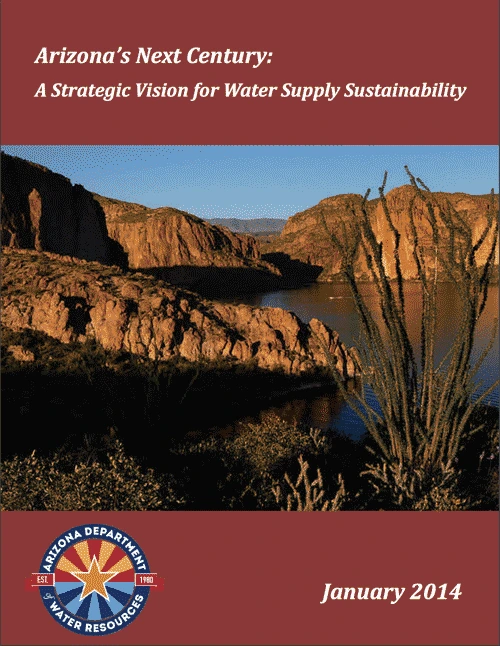Public Policy Review

Las Vegas is the site of December’s Colorado River Water Users Association (CRWUA) annual conference. All the basin states and Mexico are in attendance, with Arizona representation usually the largest. This year’s conference marked the first time there were concurrent sessions. It turns out that a statement made during the session I did not attend has caught my attention. Writer Tony Davis reported in the December 27, 2015 edition of the Arizona Daily Star on the presentation made by Jeremy Aquero, a Las Vegas economic analyst, during a session on drought. (I went instead to the concurrent session on agriculture.) Davis reports that Aquero stated: “We are not going to conserve our way to prosperity, or build our way to prosperity, and we are not going to stop growth on our way to prosperity. It will take a master-plan approach to all of those things.”
Where do we in Arizona stand in terms of planning for a secure water future?
The strategic vision document released by the Arizona Department of Water Resources (ADWR) in early 2014 listed the options for meeting Arizona’s future water needs. They include the following: increased conservation; water augmentation through multiple mechanisms; greater water reuse; possible water exchanges; and addressing some legal, regulatory, and financing issues, including the general stream adjudications and tribal water rights. See www.azwater.gov/AzDWR/Arizonas_ Strategic_Vision/.
In November of 2015 a large group convened by Arizona Town Hall to address “Keeping Arizona’s Water Glass Full” identified six priorities for action: 1) Move forward with Arizona’s Strategic Vision for Water Supply Sustainability; 2) Create and fund mechanisms to finance water supply and new infrastructure; 3) Appropriately fund and staff ADWR; 4) Education; 5) Conservation and Augmentation; and 6) Legal reform. The full report of the Town Hall can be found at aztownhall.org.
In late December, Governor Ducey appointed his Water Augmentation Council (Council), chaired by ADWR Director Tom Buschatzke, to deliberate on specific steps by “investigating long-term water augmentation strategies, additional water conservation opportunities, and funding and infrastructure needs to help secure water supplies for Arizona’s future.”
It is indeed time to move to specific action plans that can gain legislative approval, where necessary, and community support. The former will require arriving at action plans that can garner support from multiple geographic and economic interests. Although water legislation has been sparse in recent years, last year’s vote to approve extension of the tax levied by the Central Arizona Water Conservation District to fund water banking and Central Arizona Project operations proves that widespread support can be forthcoming even for measures that require local axation. Gaining broad community attention and support will require extensive public engagement. High-level treatment of brackish groundwater, seawater, or wastewater will be costly, and the same can be said about the transportation of water, especially in the era of reduced federal funding for infrastructure. In the end, it is the water consumer who pays. Hence, water consumer – all of us – must be educated as to the options and their costs.
When we consider options for closing the demand-supply gap, water conservation is often at the top of the action list for individuals and businesses. In the context of conservation, we from the water sector often speak to the savings from conservation by existing users, whether through changing out toilets, reducing outdoor watering, and/or other water use efficiencies. Planning for new uses must also be considered. How we design our communities and buildings will determine future water use. The work of landscape and building architects, along with land use planners, is highly important. I believe this nexus between design and water use will become even more important in the future. As an educator of university students, particularly at the graduate level, I see the high value of interdisciplinary training, such as we offer through the Master’s Program in Water, Society, and Policy and Ph.D. program in Arid Lands Resource Sciences. As a member of the Arizona Cooperative Extension faculty, I see the great opportunity to work with communities throughout Arizona to develop greater understanding of the available options and opportunities to work together. And as a researcher, I see the need to gain greater understanding of the tradeoffs associated with alternative water conservation, treatment, and use strategies.
In all these roles, I see the value of sharing practices and lessons learned with others. For almost a decade, I have been studying the water management strategies of Israel and have shared some of our region’s successes, particularly related to transboundary water management, through lectures and other exchanges. I have worked with researchers in Jordan to explore household use of graywater, a water source of great interest in growing, water-scarce regions. While each region’s water supply portfolio and water use practices depend on history, values, law, socioeconomic conditions, and other factors, the options for meeting future water needs are similar. They involve demand-side management, deployment of technology, education, and development of acceptable financing and funding strategies, which may include public-private partnerships. Such partnerships, which are foundational to Israel’s large-scale seawater desalination, are already playing a greater role in the Southwest. Both regions already see substantial reuse of water, with water recycling likely to play a greater role going forward in Arizona.
Throughout all deliberations, we must consider the implications of our land and water use patterns on Arizona’s quality of life and economic vitality. Our water future will require continued technological and policy innovation. A great example of the latter is Arizona’s framework for recharge and water banking. Heraclitus is said to have observed that “the only thing that is constant is change.” I have great optimism that we will adapt to changing conditions. Though we face challenges, not having the water supplies available to meet future needs is not an option.

